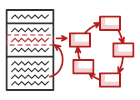
C# 状态模式讲解和代码示例
状态是一种行为设计模式, 让你能在一个对象的内部状态变化时改变其行为。
该模式将与状态相关的行为抽取到独立的状态类中, 让原对象将工作委派给这些类的实例, 而不是自行进行处理。
复杂度:
流行度:
使用示例: 在 C# 语言中, 状态模式通常被用于将基于 switch语句的大型状态机转换为对象。
识别方法: 状态模式可通过受外部控制且能根据对象状态改变行为的方法来识别。
概念示例
本例说明了状态设计模式的结构并重点回答了下面的问题:
- 它由哪些类组成?
- 这些类扮演了哪些角色?
- 模式中的各个元素会以何种方式相互关联?
Program.cs: 概念示例
using System; namespace RefactoringGuru.DesignPatterns.State.Conceptual { // The Context defines the interface of interest to clients. It also // maintains a reference to an instance of a State subclass, which // represents the current state of the Context. class Context { // A reference to the current state of the Context. private State _state = null; public Context(State state) { this.TransitionTo(state); } // The Context allows changing the State object at runtime. public void TransitionTo(State state) { Console.WriteLine($"Context: Transition to {state.GetType().Name}."); this._state = state; this._state.SetContext(this); } // The Context delegates part of its behavior to the current State // object. public void Request1() { this._state.Handle1(); } public void Request2() { this._state.Handle2(); } } // The base State class declares methods that all Concrete State should // implement and also provides a backreference to the Context object, // associated with the State. This backreference can be used by States to // transition the Context to another State. abstract class State { protected Context _context; public void SetContext(Context context) { this._context = context; } public abstract void Handle1(); public abstract void Handle2(); } // Concrete States implement various behaviors, associated with a state of // the Context. class ConcreteStateA : State { public override void Handle1() { Console.WriteLine("ConcreteStateA handles request1."); Console.WriteLine("ConcreteStateA wants to change the state of the context."); this._context.TransitionTo(new ConcreteStateB()); } public override void Handle2() { Console.WriteLine("ConcreteStateA handles request2."); } } class ConcreteStateB : State { public override void Handle1() { Console.Write("ConcreteStateB handles request1."); } public override void Handle2() { Console.WriteLine("ConcreteStateB handles request2."); Console.WriteLine("ConcreteStateB wants to change the state of the context."); this._context.TransitionTo(new ConcreteStateA()); } } class Program { static void Main(string[] args) { // The client code. var context = new Context(new ConcreteStateA()); context.Request1(); context.Request2(); } } } Output.txt: 执行结果
Context: Transition to ConcreteStateA. ConcreteStateA handles request1. ConcreteStateA wants to change the state of the context. Context: Transition to ConcreteStateB. ConcreteStateB handles request2. ConcreteStateB wants to change the state of the context. Context: Transition to ConcreteStateA. 


